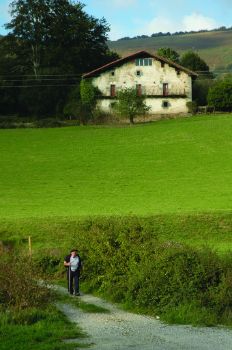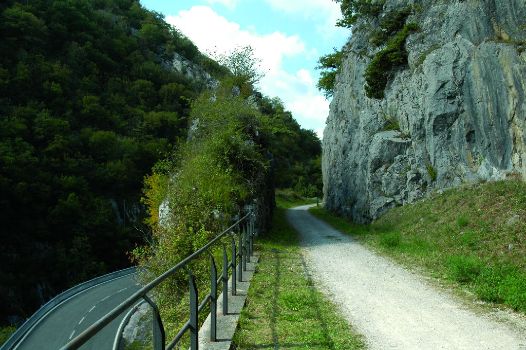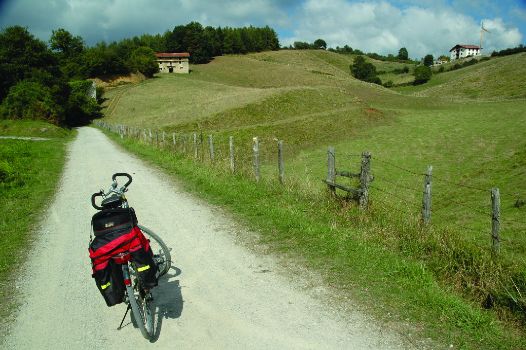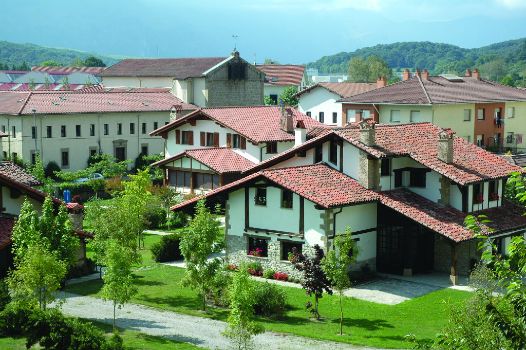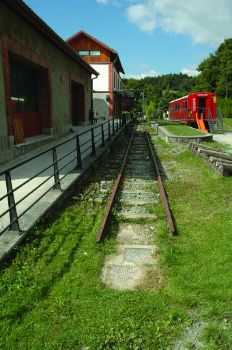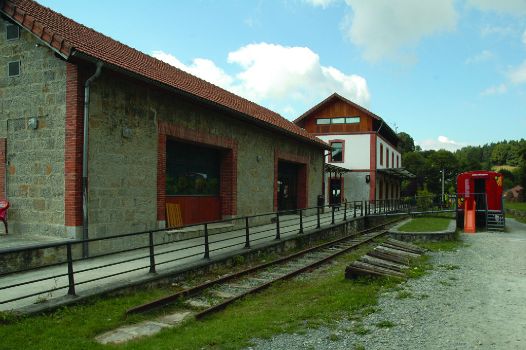Net of Natural
Trails

Plazaola Nature Trail. Plazaola - Lekunberri station Section
Description
Unique tunnels surrounded by a permanently green environment
As in many other areas in rural Spain, old railways, which run across areas with great natural beauty, have been repurposed for public use. This old railway line, besides, offers the possibilities of crossing the longest tunnel in Spain, the Uitzi tunnel, in Navarre, which is 2,700 m long.

The trail starts in a meadow in Plazaola, just by the Plazaola station, which is the border of the province. At this point there is a parking lot displaying several information panels and a milestone indicating that we are on Km 0 of the Basque stretch that runs through the province Gipuzkoa. The trail may be started along the old railway tracks that meander their way to the north, through the Leitzaran to Andoain, crossing many tunnels and viaducts over the river, all of them in perfect state. Here, too, is located the milestone indicating that we are on km 0 of the Navarrese stretch included on the El Plazaola Natural Trail.
When starting this stage, the traveller must take an asphalt road that leaves the old railway tunnel to their left; this tunnel is in too damaged a state to be used. Next, they will find the buildings corresponding to the old Plazaola station, and twice they will pass under A-15 Highway viaducts. Before passing under the second viaduct, the asphalt road turns into a dirt path. 350 m after the 2-km milestone, the traveller crosses the Gazpillotxiki tunnel, and they can admire a patch of northern red oaks (Quercus rubra) around the 3-km milestone. The landscape mixes woody areas with meadows and baserris (typical Basque houses); the trail reaches the Martikonera tunnel and runs close to the Leitza station, whose main building has been rehabilitated.
The pretty Navarrese town of Leitza is well worth a visit, although the layout of the Natural Trail does not cross it: the old railway tracks leave the village to the right and go straight into the Iruñaga tunnel. Soon after, the trail leaves the Tellería tunnel (now collapsed) to their right.
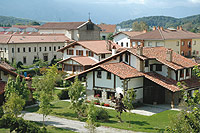
The following 4 km of trail include 4 tunnels (Kantina, Urbieta, Leitza and Malkorra), while the trail runs among woodland and pastures where Latxa sheep graze, from whose milk the famous Idiazabal cheese is made. In this stretch, the visitor can enjoy the beautiful landscape of the Leitzaran valley and the village of Leitza before leaving it behind for good. The walker will cross six more tunnels in the subsequent kilometres (Tunnel 2, Autxikeneko, Erasote, Tutenea, Tunnel 1 and Guitarran Buelta) which dot meadows and small larch (Larix decidua) patches, which later turn into indigenous species such as beeches (Fagus sylvatica), which form delicate, shadowy canopies over the traveler's heads.
A few metres after the 12-kilometre milestone, the Natural Trail reaches the entrance of the Uitzi tunnel which, with a length of 2,700 m, is the longest tunnel that can be crossed in any Natural Trail in Spain. Such tunnel runs under the water divide of two large basins: to the south, the Mediterranean Basin (the Larraun river, which is ultimately an Ebro tributary) and, to the north the Atlantic Basin (the Leitzaran river). This causes abundant water filtrations inside the tunnel, which explain the great beauty of its central area. Despite the fact that the tunnel has electric lights, due to its length, the use of torchlight is advised, as well as in all other tunnels of the Natural Trail.

Soon after the exit of the Uitzi, the trail turns right and runs along the NA-1700 for 300 m. In this section, the old Uitizi station is found, which now has been turned into a private house and farm. The traveller continues walking the trail, which now runs parallel to the NA-1700 up to the point where the trail crosses the next tunnel, and, soon afterwards reaches the Bartolo tunnel. This last section is covered by dense mixed woodlands where oaks (Quercus robur), chestnut trees (Castanea sativa), beeches, and hazels (Corylus avellana), can be found.
Soon before kilometre 18 and after a descending stretch, the layout of the trail runs parallel to the A-15 highway, and at the other side of the highway the town of Lekunberri stands. After a crossroads, and a section running along a deep trench, the trail turns right and crossed under the A-15 highway by means of a newly constructed tunnel, and then turns left to cross an unlit tunnel belonging to the original railway layout.
Finally, the trail continues leaving the Lekunberri houses to the right until reaching the old Lekunberri train stations, which now houses the Tourist Council of Plazaola and its Tourist Information Point, and where this stage ends.
Managing Entities
Sites of interest
Puntos de interés
Information
Infrastructure
- Túnel Gazpillotxiki
- Túnel Malkorra
- Túnel Tutenea
- Estación de Uitzi
- Túnel Erasote
- Túnel PK 16,5
- Túnel Iruñaga
- Túnel Aurtxikeneko
- Estación de Lekunberri
- Túnel Urbieta
- Estación de Leitza
- Túnel Leitza
- Túnel Guitarran Buelta
- Túnel de Bartolo
- Túnel Uitzi
- Túnel Martikonera
- Túnel 2
- Túnel
- Estación de Plazaola
- Túnel 1
- Túnel Kantina
Municipality
Hostel
Vegetation
Profile

(Calculated according to the MIDE criteria for an average excursionist with a light load)
Highlights
Further information
Plazaola railway line
This railway line, running on narrow railway tracks and having steam traction, was a mine train that used to take iron from the mines of Plazaola to Andoain, Guipuzkoa, in the early 20th century. In 1914, the Plazaola became a passenger train covering the 84 km between Pamplona and San Sebastián. It ran for 40 years and, during this time, it became a commercial and communication route between Navarra and Guipuzkoa, as well as a cultural exchange centre. Although it did not stand out due to its economic importance, it was very popular along its route, being commonly known as “the Plazaola”, “Plazaola train”, “Plazaola railway” and also as “txiki train” (although this nickname was also used for other trains, such as the one going from Irún to Elizondo).
This train had regular service in the following stations: Pamplona (city), Pamplona (junction), Aizoain, Sarasa, Gulina (stopping place), Irurtzun, Latasa, Lekunberri, Uitzi, Leitza, Areso (stopping place), Plazaola, Ameraun (stopping place), Olloki, Andoain, Lasarte (Bilbao – Basque Railways junction), Añorga y Donostia (Amara). There were two other stopping places, Bizkotx and Beiñes, which did not appear among the train regular stops.
The passenger transport line was closed due to the floods occurred in October 1953, which destroyed several bridges and railway track sections, making the railway useless, in addition to the tough competition with the coach lines. However, it continued providing some goods transport services in the Leitzaran of Guipuzkoa. In 1958, the railway was definitively closed, the track was lifted and the facilities dismantled.
Today, a great part of the old railway track has been recovered as a route for leisure activities, making up the Plazaola Nature Trail, which runs among meadows, forests, both native (oaks, beeches, alder trees...) and reforestation pines. It also crosses the Larraun valleys and the Leitzaran river (which has been declared a Protected Biotope).



